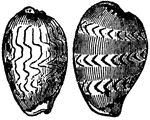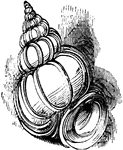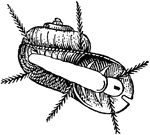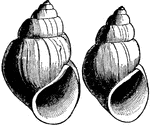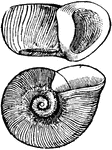
Cypraea Moneta (Linnaeus)
"The Money Cowry is a little, oval shell, depressed, flat below, with very thick edges and slightly…
!["The Madagascar Cowry [is] beautifully marked, having the general appearance of being mammillated all over."](https://etc.usf.edu/clipart/51500/51521/51521_cypra_madaga_mth.gif)
Cypraea Madagascariensis (Gmel.)
"The Madagascar Cowry [is] beautifully marked, having the general appearance of being mammillated all…
!["The Granular Cowry [is] beautifully marked, having the general appearance of being mammillated all over."](https://etc.usf.edu/clipart/51500/51525/51525_cypra_nucleu_mth.gif)
Cypraea Nucleus (Linnaeus)
"The Granular Cowry [is] beautifully marked, having the general appearance of being mammillated all…
Mitra Episcopalis (Lamarck)
"The Episcopal Miter, from the Indian ocean is white, ornamented with square spots of a fine red, and…

Mitra Papalis (Lamarck)
"The Papal Miter has dentiform folds around the opening, which also crown each turn of the spiral. It…

Oliva Erythrostoma (Lamarck)
"The genus Oliva is so named from its resemblance in form to the olive. They are flesh-eaters."

Oliva Porphyria (Lamarck)
"The genus Oliva is so named from its resemblance in form to the olive. They are flesh-eaters."

Oliva Peruviana (Lamarck)
"The genus Oliva is so named from its resemblance in form to the olive. They are flesh-eaters."
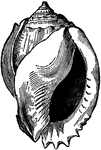
Cassis Glauca (Linnaeus)
"In the genus Cassis the shell is oval, convex, and the spire is not of considerable height.…

Cassis Rula (Linnaeus)
"In the genus Cassis the shell is oval, convex, and the spire is not of considerable height.…
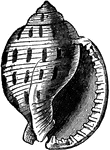
Cassis Canaliculata (Brugieres)
"In the genus Cassis the shell is oval, convex, and the spire is not of considerable height.…
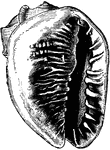
Cassis Madagascariensis (Lamarck)
"In the genus Cassis the shell is oval, convex, and the spire is not of considerable height.…

Cassis Madagascariensis (Lamarck)
"In the genus Cassis the shell is oval, convex, and the spire is not of considerable height.…

Cassis Zebra (Lamarck)
"In the genus Cassis the shell is oval, convex, and the spire is not of considerable height.…
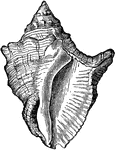
Purpura Consul.
"The Purpuras have a classical name and history, having furnished the Greeks and Romans with the brilliant…

Buccinum Senticosum (Linnaeus)
"The Purpuras have a classical name and history, having furnished the Greeks and Romans with the brilliant…

Voluta Undulata (Lamarck)
"The Volutes live in the sands near the shore; sometimes they are found high and dry, left by the retreating…

Voluta Cymbium (Linnaeus)
"The Volutes live in the sands near the shore; sometimes they are found high and dry, left by the retreating…

Voluta Delessertii (Petit)
"The Volutes live in the sands near the shore; sometimes they are found high and dry, left by the retreating…

Voluta Musica (Linn.)
"The Volutes live in the sands near the shore; sometimes they are found high and dry, left by the retreating…

Voluta Imperialis (Lamarck)
"The Volutes live in the sands near the shore; sometimes they are found high and dry, left by the retreating…

Voluta Scapha (Gmel.)
"The Volutes live in the sands near the shore; sometimes they are found high and dry, left by the retreating…

Voluta Vexillum (Chem.)
"The Volutes live in the sands near the shore; sometimes they are found high and dry, left by the retreating…

Conus Tescallatus (Born.)
"The genus Conus is especially rich in species, as well as numerous individuals. This group…

Conus Nobilis (Linn.)
"The genus Conus is especially rich in species, as well as numerous individuals. This group…

Conus Gloria Maris (Chemn.)
"The genus Conus is especially rich in species, as well as numerous individuals. This group…

Conus Textilis (Linn.)
"The genus Conus is especially rich in species, as well as numerous individuals. This group…

Triton Anus (Lamarck)
"The genus Triton is classed next to the genus Murex. The shell is irregularly covered…

Strombus Gigas (Linnaeus), with the animal
"The Strombus is a peculiar genus, belonging to the equatorial seas. Some of these attain great…
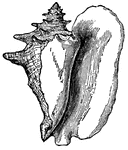
Shell of Strombus Gigas
"The Strombus is a peculiar genus, belonging to the equatorial seas. Some of these attain great…
!["The Angel-winged is shown [here]. It is veined with stripes of white and red, and comes from the coasts of Asia and America."](https://etc.usf.edu/clipart/51600/51610/51610_strom_gallus_mth.gif)
Strombus Gallus (Linn.)
"The Angel-winged is shown [here]. It is veined with stripes of white and red, and comes from the coasts…

Common Whelk
The common whelk (Buccinum undatum) is a large edible sea snail and a gastropod mollusk.
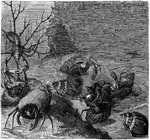
Hermit Crabs
An illustration of hermit craps shedding their shells and finding new ones. As hermit crabs grow they…

Wentletrap
The wentletrap (Scalaria pretiosa) is gastropod mollusk named after its spiral staircase appearance.

Wentletrap
The wentletrap (Scalaria pretiosa) is gastropod mollusk named after its spiral staircase appearance.
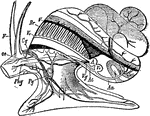
Circulatory and Nervous System of a Snail
Circulatory and nervous system of a snail. Labels: F, tentacles; Oe, esophagus; Cg, cerebral ganglion;…

Scorpion Conch
The scorpion shell (Pteroceras lambis) is a large sea snail in the Strombidae family of conchs.

Common Periwinkle
The common periwinkle (Littorina littorea) is an edible species of sea snail in the Littorinidae family…

Violet Snail
The violet snail is a floating sea slug. The snail is able to float due to the mucus covered raft that…

Naticoid
Naticina papilla is a species of naticoid, a predatory sea snail in the gastropod class of Mollusca.

Naticoid
Naticina haliotoides is a species of naticoid, a predatory sea snail in the gastropod class of Mollusca.

Slit Worm Snail
The shell of a Slit Worm Snail (Siliquaria anguina). The species is a gastropod mollusc that has an…
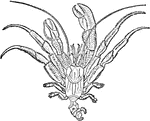
Hermit Crab
Hermit crabs are decapod crustaceans of the superfamily Paguroidea. They are not closely related to…
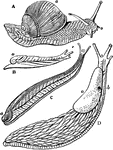
Snail and Slug
A series of Stylommatophorous Pulmonata, showing transitional forms between snail and slug.

Northern Moon Snail
Lunatia heros or the Northern moon snail, the common salt-water snail of the Atlantic coast.
